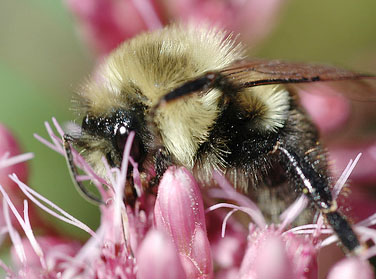Introduction
These web pages are for people that wish to know more about Michigan bumblebees -- what species are found here, basic biology, and resources for more in-depth information.
Bumblebees are native eusocial bees. The common honeybee, Apis mellifera, in not native to North America. In places such as the Upper Peninsula of Michigan, bumblebees are ubiquitous, and honeybees are absent unless brought in commercially. Bumblebees (Bombus) differ from honeybees in several ways, the most significant being that bumblebee colonies last for only one season. Honeybee colonies are perennial, with a long-lived queen. See life cycle for more information.
Bumblebees In Peril?
Recent studies have shown that some species of bumblebees may be in decline in North America. While no single cause seems to have been found, evidence suggests that introduction of managed bumblebees within greenhouse operations may be one factor. Other factors include deteriorating habitat conditions, loss of nest sites in suburban environments, and climate change.
There are organizations devoted to preserving our bumblebee fauna, and scientists are in need of recently-collected specimens to ascertain the current range of some of the target species.
What Species are in Michigan?
Michigan currently is known to have 19 species of bumblebees within its borders. Some of them are very common and widespread, others are restricted to the Upper Peninsula, and are northern species.
This pictorial checklist of Michigan bumblebees is based upon the collections of the UMMZ, the 1980 paper by Husband, Fischer and Porter, and the best available information from web and print sources (see References Section). All of the specimens photographed are from the UMMZ collection. Specimens are shown at approximately the same scale.
